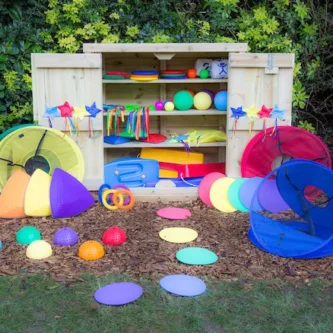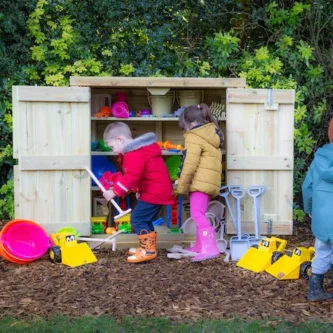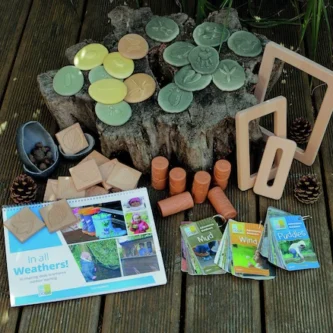In this blog we explore the importance of outdoor learning and how creating outdoor classroom spaces can offer a wealth of ideas and activities to improve children’s health and well-being, whilst also helping to engage them in learning. We offer 11 outdoor learning activities you can try and some ideas for planning outdoor learning across the curriculum.

Let nature be your teacher
William Wordsworth
We all know and understand the many different benefits that outdoor education can have and how it is not only beneficial to children’s well-being, but also, a great way to renew their enthusiasm for learning.
What is outdoor learning?
In summary, it is simply any learning experiences that take place outside the normal classroom environment. Taking learning beyond the classroom walls not only enhances children’s curiosity, but also helps them to build resilience and foster a deeper connection with the world around them. Furthermore, children have the freedom to explore, try things out and discover using all their senses. It is an inquiry-based way of studying so can be full of open-ended investigations giving pupils a deeper understanding.
Why teach outdoors?
- The outdoors gives a real-world context to learning and therefore enables pupils to better interpret and engage with the world around them.
- It compliments indoor teaching and what’s more enhances children’s understanding.
- Supports emotional and physical well-being, helping to reduce stress and improve mood-both for pupils and staff.
- Boosts confidence and therefore also impacts positively on attitudes and self-esteem.
- It also has the potential to develop collaboration skills as children move around and work with others in groups.
- Able to create awe and wonder and as a result will help to increase understanding of the importance of caring for the natural world.
Besides, it can also be great for the environment. As when working outside you can reduce the amount of electricity you need for working in school!
In general, outside classrooms allow children to learn from direct experience and follows the principle that children are learning everywhere and all the time.
Learning outdoors can also support the curriculum and therefore outdoor activities can be incorporated into lessons and used to teach a wide range of topics across many subjects. For that reason, teachers and practitioners can explore the natural environment and then look for best opportunities to deliver the curriculum beyond the classroom walls.
Ideas for embedding outdoor learning into the curriculum:
English
| KS1 | LKS2 | UKS2 | |
|---|---|---|---|
|
|
|
Maths
|
|
|
Science
|
|
|
Further outdoor learning ideas across the curriculum:
ICT
Technology such as Rugged Robot along with the outdoor data logger backpack.
• Big point recordable buttons.
• Similarly other talking devices such as clipboards and pegs.
• Outdoor camera or time lapse & motion activated camera.
Art and Design
|
|
|
Outdoor Learning Resources
There are many outdoor learning resources and our Outdoor Learning Collections offer a wide range of engaging resources that support learning across the curriculum. From maths and literacy to gardening, well-being and physical development, every collection has activity ideas available to download online. Therefore, utilising the special nature of outdoors to deliver learning in an exciting and engaging way.
11 activity ideas which have been inspired by our outdoor learning collections:
Physical Development

Move It
Use a movement dice or make a set of movement cards to use. Ask children to roll the dice or select a card and then copy that movement. These could include star jumps, jogging on the spot, hopping on one leg, etc. Then extend the activity by asking them to create a mini sequence with multiple movements.
Messy Play

Concoctions Corner
Turn your mud kitchen into a concoctions corner and ask the children to create their most imaginative concoction. Encourage them to think and talk about what ingredients they will include, what their concoction is for and what it will be called. As a result pupils could create a Super Shrinking Serum or a Positivity Potion!
Construction

Build The Future
Encourage the children to use their imaginations to build the future. For instance, Can they invent, design and build a robot, a car or a space rocket? What will these look like and what special features will they have?
Sand and Water

Don’t Spill the Water or Sand
Challenge the children to work together to get the water/sand from one bucket or area to another using the different resources. Can they identify which resources would be the best to use and which ones they should try and avoid, such as those with holes in! You could set it up as a challenge and see who has the most water/sand when they reach their destination.
Reading and Storytelling

Create A Story
Select your favourite outdoor reading and storytelling space. You might want to sit under a tree, in the sunshine or create a new reading den! Choose a resource from your outdoor space, such as a puppet from your reading collection or a leaf, stone or stick. Create a story about this item. Where might it have come from? What can it do? What will happen when you pick it up? For example, a mysterious leaf could have fallen from a secret kingdom in the clouds, or a twig might turn into a key to open a secret passageway.
Active Literacy

Scrabble Run
Firstly, start by laying out a selection of phonics mats on the floor and covering them up with cones. Split your group into equal teams. One person at a time from each team must run, uncover a grapheme and take it back to their group. The next person then runs to find another mat. Keep taking turns to collect graphemes until you can make a word. The winning team can either be the first team to make a word or the team with the most words at the end.
Maths

Create a Calculation
Collect natural resources or use resources from the learning collection to create a calculation for a partner to solve. For example, you could use operation cones, numerals, number frames or sticks, stones and leaves to represent numbers.
PE and Mini Leaders

Keep It Still
Choose a resource such as a hoop, quoit, beanbag or ball and try to balance it on your body in different ways. You could time how long you can balance different resources. For example, who can balance a beanbag on their head whilst standing on one leg for the longest?
Well-being and Calming

Calming Cards
Explore a selection of different calming resources and calming techniques. Find ones that help you to feel calm. This could be a rain stick, weaving frame, emotions mats, drawing, etc. You could also try balancing, breathing exercises or mindfulness activities. Create your own set of personal calming cards with strategies that can be used to help you feel calm and relaxed.
School Garden

Attracting Visitors
Some animals and creatures are good for our gardens. Research the different garden visitors that you would want to attract to your garden, such as butterflies and bees. Then find out the best ways to attract these visitors and what benefits they will bring for your garden. Put these actions into place and then spend time each day observing what visitors you receive. The use of outdoor cameras and talking devices will be useful here because they’ll be able to capture some of the experiences.
Forest School

Natures Treasures
Explore the natural world with fun woodland adventures. For example, go on a nature scavenger hunt and search for natures treasures. Tick off all the things found and then with items that they are able to move create beautiful outdoor art pictures. In addition, you could also teach pupils how to identify trees based on their leaves, bark or other characteristics. Also, make leaf and bark rubbings and use these to create pieces of art.
In Conclusion
Thank you for reading this blog. We hope that our outdoor learning activity ideas have been able to give you some inspiration for supporting learning outside.
So celebrate outdoor learning and play and encourage everyone to go outside each day to enjoy learning in the wonderful natural classroom of the great outdoors!
Written by our Primary Curriculum Content Editor Rachel Betteridge. Rachel is a qualified teacher with 26 years experience teaching across the primary sector.



